San Lorenzo in Lucina

San Lorenzo in Lucina is a basilica of Rome, dating back to the 4th century, and dedicated to Saint Lawrence, Roman deacon and martyr.
The name Lucina comes from the Roman matron owner of the house on which the church was built.
Pope Marcellus I hid here during Maxentius' persecution, while Pope Damasus I was elected here in 366. The church was known as Titulus Lucinae, and thus is mentioned in the acts of the 499 synod of Pope Symmachus.
To the 5th century dates back a tradition that wanted a litany each 25 April, starting from San Lorenzo in Lucina and ending in St Peter's Basilica.The Cardinal Priest of the Titulus S. Laurentii in Lucina is Luigi Poggi.
Art and architecture
The facade dates back to the 1112 rebuilding by Pope Paschal II, while the interior was completely changed by Cosimo Fanzago in 1650, with the old lateral naves changed in Baroque chapels.
The high altar, designed by Carlo Rainaldi, is decorated with a Crucifixion by Guido Reni. Under the altar there is the gridiron on which St Lawrence was martyred. The relics were put here by Pope Paschal II, according to an inscription on the throne behind the altar. The chorus is decorated by Virgins and Saints by Placido Costanzi.
The second chapel to the right, designed by Carlo Rainaldi, was decorated by Jan Miel. Nicolas Poussin is buried in the second chapel on the right, with a monument donated by Chateaubriand with a bust by Paul Lemoyne and a relief by Louis Desprez.
The fourth chapel, the Fonseca chapel, was designed by Gian Lorenzo Bernini, and features a lively bust of Gabriel Fonseca by the master sculptor. It also houses a copy of Guido Reni's Annunciation completed by Giacinto Gimignani. The fifth chapel on the right has a Death of St. Giacinta Marescotti by Marco Benefial and a Life of St. Francis(1624) by Simon Vouet. The fourth chapel has a St. Giuseppe by Alessandro Turchi and a San Carlo Borromeo by Carlo Saraceni. The first chapel has works (1721) by Giuseppe Sardi.
References
- "San Lorenzo in Lucina", Nyborg.
